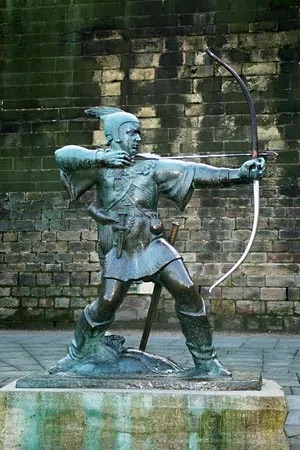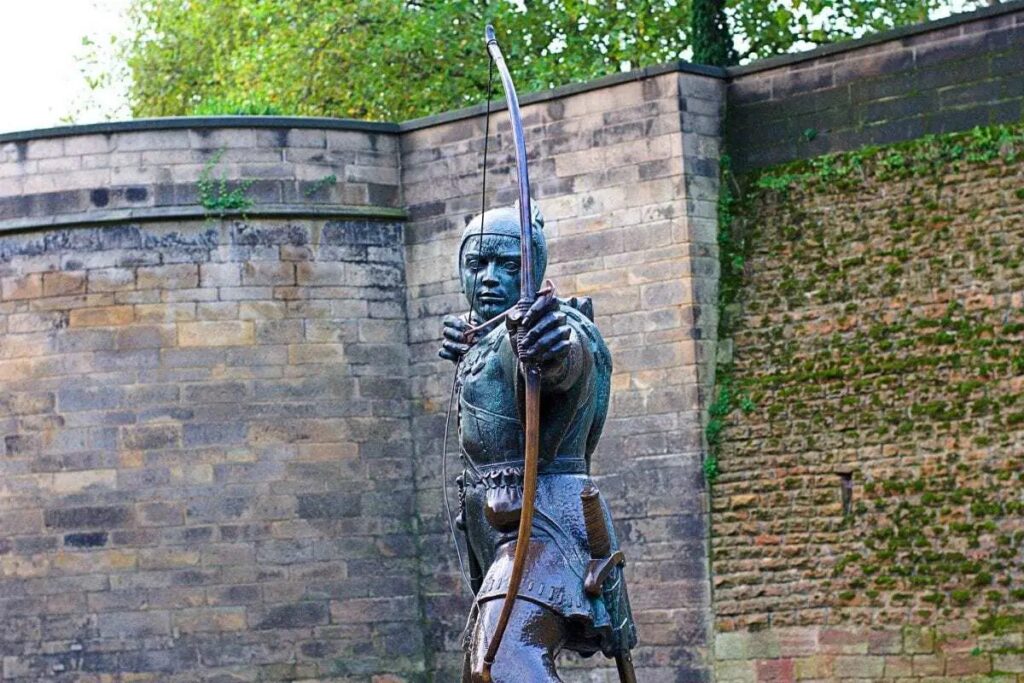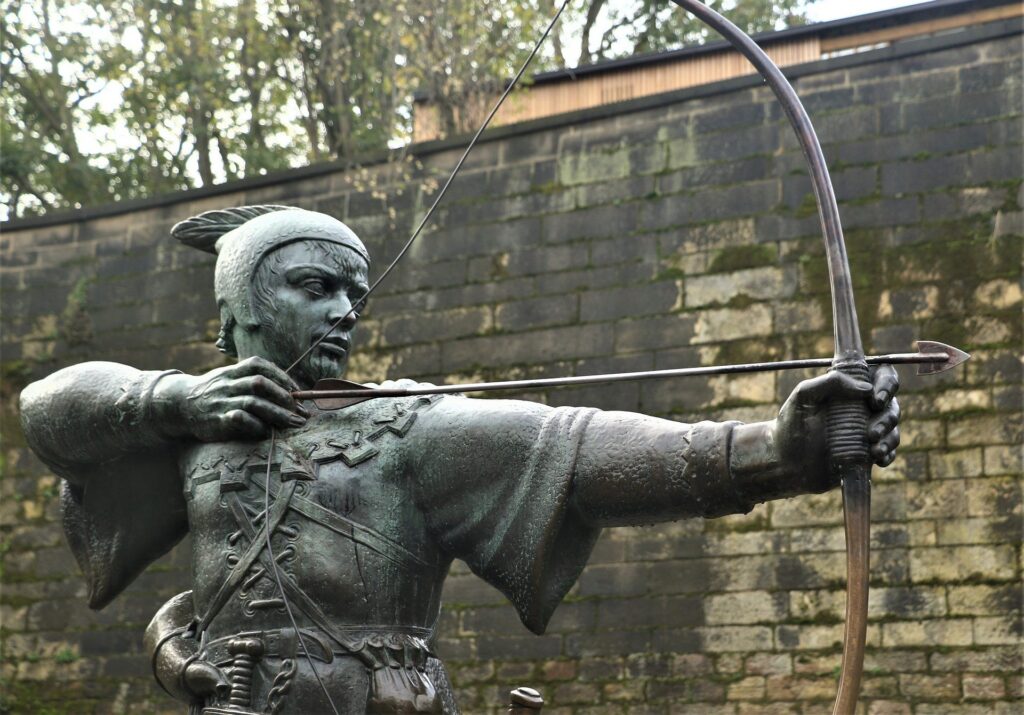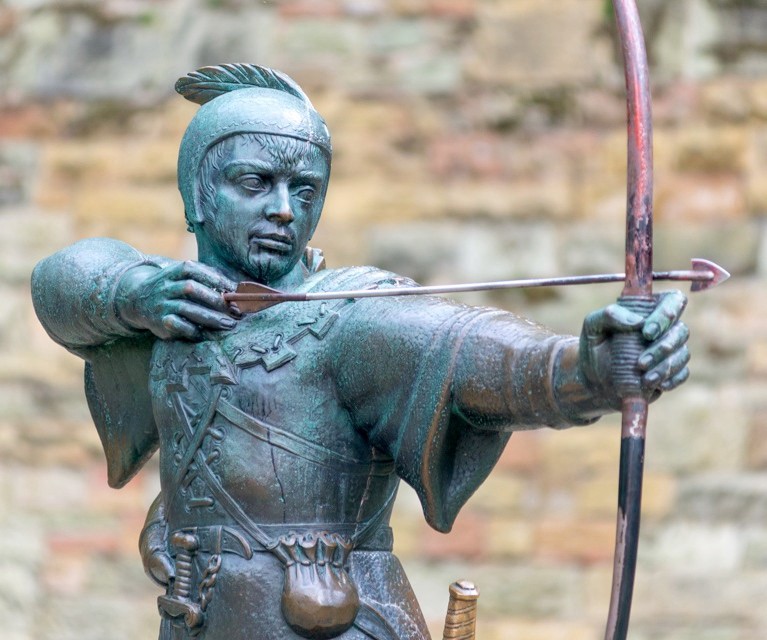For generations, the story of Robin Hood has enchanted both the young and the old. This clever outlaw and his loyal Merry Men have appeared in literature, poetry, theater, movies, TV series, and video games. Even after 700 years since his first mention in English literature, Robin Hood remains a beloved figure. Let’s explore the origins of this tale, its evolution, and investigate the possibility of his existence.
Medieval Origins
Robin Hood’s first recorded mention is in the 14th-century work “Piers Plowman” by William Langland. Although he is only briefly mentioned, it suggests that he was already a well-known figure, indicating his popularity even before becoming a staple in medieval ballads and poetry.
The name ‘Robin Hood’ might have been a common alias for outlaws in medieval times. Historical records from as early as the 1260s include variations such as ‘Robehod’, ‘Robinhood’, and ‘Robbehod’, found in legal documents from Berkshire to York. This suggests that the name was widely recognized in the 13th century.

Robin Hood’s rise to prominence can be traced back to the ballad “Robin Hood and the Monk,” written in the 1450s. This narrative established key elements of the legend, such as the setting of Nottingham and Sherwood Forest, the infamous Sheriff of Nottingham, and his merry companions, including Little John and Much the Miller’s Son.
After this ballad, Robin Hood’s story quickly evolved. The May Day Games, where medieval commoners reenacted scenes from his adventures, introduced Maid Marian as his love interest. Subsequent ballads and poems like “A Guest of Robin Hood,” “Robin Hood and the Potter,” and “Robin Hood and the Sheriff of Nottingham” brought in characters like Will Scarlet and the beloved Friar Tuck. These stories emphasized Robin Hood’s cleverness and wit over physical combat and included the first account of his death by poisoning.
Notably, early accounts lacked some now-famous aspects of Robin Hood’s character: his role in redistributing wealth from the rich to the poor and his noble lineage. Instead, in the 15th century, Robin Hood and his Merry Men were portrayed as rugged outlaws driven by self-interest, with Robin depicted as a man of the people rather than a nobleman.
During the Tudor era, the legend of Robin Hood underwent significant changes. Anthony Munday’s late 16th-century plays, “The Downfall of Robert Earl of Huntingdon” and “The Death of Robert Earl of Huntingdon,” introduced the idea of Robin Hood’s noble origins. This depiction of Robin Hood as a dispossessed nobleman resonated strongly and has been a persistent element in later versions. The plays also portrayed him as a loyal warrior for King Richard I, participating in the Crusades, which brought Prince John into the story as a main antagonist alongside the Sheriff of Nottingham and Sir Guy of Gisborne, the latter being introduced in a children’s tale from the 1650s.

The method of sharing Robin Hood’s adventures shifted from oral performances to written narratives during this period. Broadside Ballads, affordable sheets printed with stories or songs, became widely popular and introduced new episodes to the legend, such as the famous quarterstaff duel with Little John. In the 17th century, these ballads added Alan-a-Dale to the band of Merry Men.
Robin Hood’s image as the benevolent bandit was solidified in 1795 with the publication of Joseph Ritson’s “Robin Hood: A collection of all the Ancient Poems Songs and Ballads now extant, relative to that celebrated Outlaw.” His portrayal as a champion of the poor, stealing from the rich to support them, captured the public’s imagination and has remained a central aspect of his story ever since.
In the Victorian era, Robin Hood’s story was adapted for a younger audience for the first time, with Howard Pyle’s 1883 work, “The Merry Adventures of Robin Hood,” being particularly notable. Pyle’s version diverged from the traditional portrayal of Robin Hood as a nobleman and ended with King Richard the Lionheart granting a pardon to Robin Hood and his followers, a narrative element that would appear in later 20th-century adaptations.

During this period, Sir Walter Scott and Jacques Thierry, along with the collection known as the Child Ballads, added new dimensions to the legend. Scott and Thierry depicted Robin Hood as a Saxon hero opposing corrupt Norman rulers, while the Child Ballads introduced the famous archery contest, a clever trap set by the Sheriff of Nottingham. These elements—conflict with the Normans and the archery contest where Robin Hood famously splits his rival’s arrow—became enduring parts of the legend.
The 20th century revitalized the Robin Hood saga through cinema and television. Early silent films like 1908’s “Robin Hood and His Merry Men” and the 1938 classic “The Adventures of Robin Hood” with Errol Flynn marked the beginning of Hollywood’s fascination with the tale. The story has been portrayed in various forms, from Douglas Fairbanks’ 1922 silent film to Kevin Costner’s “Robin Hood: Prince of Thieves” in 1991, and from Sean Connery’s portrayal of an older Robin in “Robin and Marian” to the animated Disney version. For over a century, this quintessentially English folklore has been a cinematic staple.
Television has also played a significant role in keeping the legend alive for more than 70 years, with notable portrayals by Richard Greene in the 1950s and Michael Praed and Jason Connery in the 1980s series “Robin of Sherwood.” The enduring popularity of Robin Hood is further bolstered by a wealth of books, toys, board games, and video games, ensuring that his story remains vibrant and relevant.
The existence of Robin Hood as a historical figure remains unproven. While the idea of a charismatic bandit in Sherwood Forest who redistributes wealth from the rich to the poor is appealing, there is no solid evidence that Robin Hood, Maid Marian, Little John, or Friar Tuck were real people.
Given the harsh realities of medieval life, where comfort was reserved for the elite, it’s easy to see why the masses would be drawn to stories of a brave group challenging the wealthy. However, these tales are simply that—stories.
In fact, the name ‘Robin Hood’ was used by some outlaws in the 13th century, but these individuals bore little resemblance to the heroic figure of legend. Robin Hood, much like King Arthur, has become an enduring myth, a compelling story embedded in cultural folklore.
